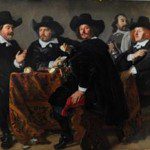Dutch Golden Age Celebrated at National Gallery With ‘Civic Pride’ Portraits
By • March 15, 2012 0 1321

“Civic Pride: Dutch Group Portraits from Amsterdam” is now on view at the National Gallery of Art. The special installation involves two large-scale group portraits, rarely seen outside the Netherlands.
Two of Amsterdam’s most important portraitists from the mid-17th century, Govert Flinck (1615–1660) and Bartholomeus van der Helst (1613–1670), captured the confidence of the men who governed the Kloveniersdoelen, the building where one of Amsterdam’s three militia companies held its meetings. The painting were created during the years the Dutch controlled New Amsterdam, which was to become New York City.
“These group portraits offer a remarkable visual record of the inner workings of the Dutch Republic at the height of its presence on the global stage in the 17th century,” said Earl A. Powell III, director, National Gallery of Art. “It was through the efforts of the citizens depicted, and the civic organizations they represented, that the young republic achieved its economic, political and artistic golden age. We are not only grateful to the Rijksmuseum and Amsterdam Museum for lending these masterpieces to the Gallery for a period of five years, but also to the city of Amsterdam, which owns the works, for agreeing to this generous loan.”
Also, at the March 9 reception for the exhibit was Renee Jones-Bos, Ambassador of the Netherlands to the United States. Arthur Wheelock, Jr., is the curator for Northern Baroque paintings at the National Gallery of Art. One of the paintings depicts an ancestor of the exhibit’s research assistant Henriette de Bruyn Kops.
The two works, both titled “Governors of the Kloveniersdoelen,” were painted 13 years apart. Flinck (in 1642) and Van der Helst (in 1655) created comparable yet distinct interpretations of the shared sense of duty and personal interactions of two different generations of governors. The attire and demeanor of the governors varies from painting to painting, reflecting the different decades in which the men were portrayed. The two canvases are on long-term loan from the Rijksmuseum and the Amsterdam Museum, respectively. A new type of portraiture appeared in the northern Netherlands in the 17th century: large group portraits depicting the leadership of professional and civic organizations. Guild administrators, government officials, board members of charitable institutions and officers of militia companies commissioned distinguished artists to create these large-scale group portraits, destined for the walls of the organizations’ headquarters. The portraits often depict the sitters in the midst of a meeting or a meal, emphasizing the members’ shared responsibilities, personal interactions and civic-mindedness.
Flinck and Van der Helst were two of the most renowned portraitists of their time. Flinck had trained under Rembrandt, and like his famous teacher, specialized in both history paintings and fashionable portraiture. Van der Helst was famous for the elegant realism of his portraits and was a favorite artist of the Amsterdam militia companies. His version of “Governors of the Kloveniersdoelen” (1655) has just undergone a complete restoration for the occasion of the exhibition. The results are dramatic, as the painting now has a brilliance of color that was obscured by old varnish for many years. Although hundreds of group portraits were painted during the 17th century, they are rarely seen outside the Netherlands; many still remain with the organizations that originally commissioned them.
The exhibit runs through March 11, 2017.
- Flinck’s “Governors of the Kloveniersdoelen” | Photo provided by National Gallery of Art
- Photo provided by National Gallery of Art



